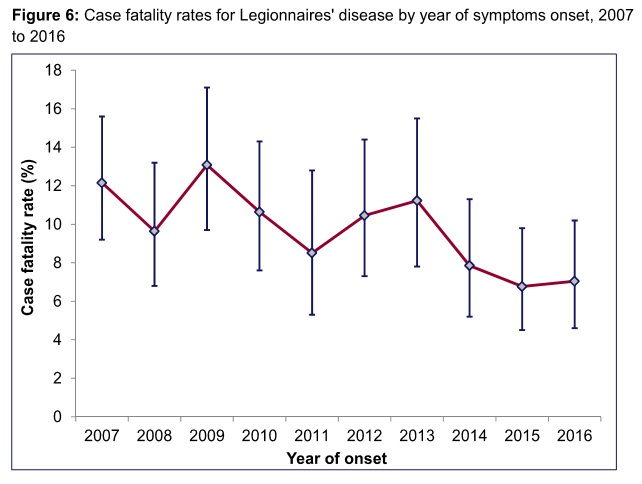The 2016 UK Legionnnaires’ disease analysis from PHE has some interesting information including analyses not previously provided. Overall the results show that 2016 levels of death from Legionella bacteria were decreasing however the number of cases are higher than the annual case numbers observed previously between 2011 and 2014 and is above the 349 mean annual number of cases observed since 2006.


The ratio between males and females showed 2.4:1 which reflects the numbers found internationally. Also the age range of cases has shown little year on year change.
Seasonality shows the same pattern as previous years. The overall Legionnaires’ disease incidence rate for England and Wales was 6.1 cases per million population.
Other factors such as underlying causes and the categories pf exposure remained similar to previous years.
The most interesting change was in mortality where the rate of death from Legionnaires’ disease continues to fall.

Among 2016 cases, 21 of the 25 deaths were in males with a median age of 70 years and four females with a median age of 76 years. The age at death in females diagnosed with Legionnaires’ disease has increased by more than 10 years since 2014 compared to the median age at death in males which decreased slightly from 74 to 70 years for the same time period.
The 3 most common STs identified in clinical samples from cases with onset of symptoms during 2016 remains consistent with those strains most commonly identified in 2014 and 2015. In 2016, ST47 accounted for 3.6% of all cases with isolates, followed by ST42 (2.8%) and ST1 (1.9%).

Figure 8 shows the distribution of STs according to the principal category of exposure and suggests that cases associated with travel abroad had a greatest diversity of STs compared to cases principally exposed to a source from within the community. Only four of the 31 STs identified in 2016 were found to be common to both the community and travel abroad exposure categories whilst ST23 was the only strain identified in one or more cases association with a healthcare facility. ST23 however was also identified among cases associated with travel abroad.
It is interesting to note that the vast majority of cases of Legionnaires’ disease are identified using the urinary antigen test. However this test primarily detects Legionella pneumophila serogroup 1 so it is perhaps not surprising that the most prolific cause of Legionnaires’ disease is Legionella pneumophila serogroup 1.
Collaton Consultancy Limited can help you manage Legionella bacteria on your site helping you to comply with L8 and HSG 274. If you need help with training, writing Written Scheme’s or Water Safety Plan’s, creating suitable processes and systems to manage your water systems on site then contact us on general@collatonconsultancy.com or phone on +44 (0)7958 124563.


